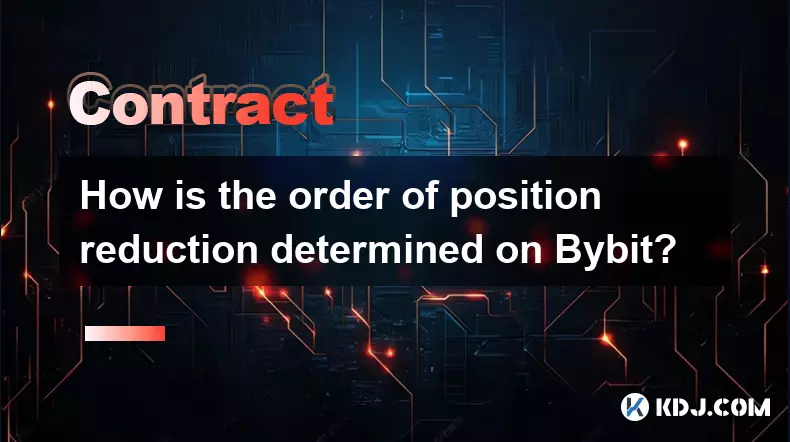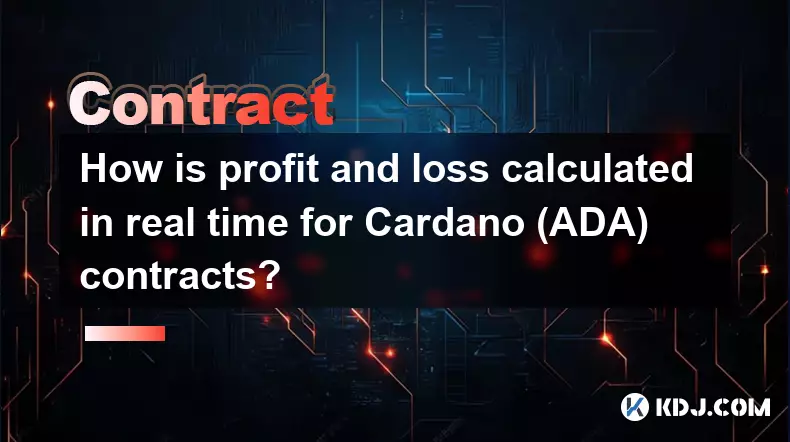-
 bitcoin
bitcoin $109667.069529 USD
-3.03% -
 ethereum
ethereum $3936.685804 USD
-4.07% -
 tether
tether $1.000493 USD
0.01% -
 xrp
xrp $2.771823 USD
-4.74% -
 bnb
bnb $957.805027 USD
-5.34% -
 solana
solana $196.735100 USD
-6.68% -
 usd-coin
usd-coin $0.999727 USD
-0.01% -
 dogecoin
dogecoin $0.227355 USD
-5.12% -
 tron
tron $0.335205 USD
-0.81% -
 cardano
cardano $0.779256 USD
-3.59% -
 ethena-usde
ethena-usde $0.999900 USD
-0.06% -
 hyperliquid
hyperliquid $42.492095 USD
-6.61% -
 chainlink
chainlink $20.501853 USD
-4.34% -
 avalanche
avalanche $28.952606 USD
-11.21% -
 stellar
stellar $0.356038 USD
-3.93%
How is the order of position reduction determined on Bybit?
Bybit reduces positions based on risk metrics like margin ratio and leverage, prioritizing high-risk trades while using ADL to maintain system stability during extreme volatility.
Sep 22, 2025 at 06:01 am

Understanding Position Reduction Mechanics on Bybit
Bybit employs a systematic approach to manage position reductions, particularly during volatile market conditions or when users approach liquidation thresholds. The process ensures fairness and transparency across all active positions. Each user’s margin level, leverage setting, and order type directly influence how and when their positions are reduced.
The sequence of position reduction is not arbitrary; it follows predefined risk parameters set by the platform to maintain system stability.Factors Influencing Reduction Priority
- Positions with lower margin ratios are prioritized for reduction as they pose higher risk to the platform’s solvency.
- Contracts nearing liquidation are evaluated in real-time using the Mark Price mechanism to prevent unfair executions.
- Isolated margin positions are assessed independently from cross-margin accounts, leading to different reduction triggers.
- Users employing high leverage face earlier reductions due to amplified exposure relative to their collateral.
- The time of entry does not affect reduction order—only current risk metrics determine action priority.
Liquidation and Auto-Deleverage System (ADL)
- When a position's equity falls below maintenance margin, liquidation procedures initiate automatically.
- Bybit uses a Insurance Fund to cover most liquidations, minimizing reliance on ADL under normal conditions.
- In extreme volatility, if the Insurance Fund is insufficient, the ADL system activates to offset losses.
- ADL ranks counterparties based on profitability, starting with the most profitable short or long positions.
- Traders affected by ADL are notified through real-time alerts and can monitor their rank via the ADL indicator.
User-Controlled Risk Mitigation Strategies
- Adjusting leverage manually allows traders to reduce susceptibility to early position reduction.
- Increasing margin allocation in isolated mode enhances buffer against price fluctuations.
- Setting stop-loss orders helps exit positions before automatic systems intervene.
- Monitoring the estimated liquidation price enables proactive adjustments to open trades.
- Utilizing take-profit levels ensures partial exits at desired prices, lowering overall exposure.
Frequently Asked Questions
What triggers a position reduction on Bybit?A position may be reduced when its margin balance drops close to the maintenance threshold. This typically occurs due to adverse price movement eroding available equity. The system initiates partial or full closure depending on contract type and risk settings.
Does Bybit notify users before reducing a position?Yes, Bybit sends real-time notifications when a position enters a high-risk zone. These alerts appear within the app and may also be delivered via email or push notification, allowing users to act before automatic measures take effect.
How is the ADL ranking determined?ADL ranking is based on the profitability of opposing positions. The most profitable traders are first in line during an auto-deleveraging event. This ensures that those benefiting the most from market moves contribute proportionally during exceptional scenarios.
Can I avoid being impacted by ADL?Traders can reduce ADL exposure by closing highly profitable positions proactively or avoiding holding large winning trades during periods of high volatility. Using lower leverage and maintaining healthy margin levels also decreases the likelihood of involvement.
Disclaimer:info@kdj.com
The information provided is not trading advice. kdj.com does not assume any responsibility for any investments made based on the information provided in this article. Cryptocurrencies are highly volatile and it is highly recommended that you invest with caution after thorough research!
If you believe that the content used on this website infringes your copyright, please contact us immediately (info@kdj.com) and we will delete it promptly.
- Hashdex, Crypto ETFs, XRP & Solana: A New Era for Digital Asset Investing
- 2025-09-26 18:25:12
- Crypto Market Slowdown? Year-End Rally Still in Play!
- 2025-09-26 18:25:12
- XRP, RLUSD, and the Derivatives Market: A New York Minute on Crypto's Next Big Thing
- 2025-09-26 18:45:15
- Bitcoin Price Under Pressure: Is $105,000 Still in Play?
- 2025-09-26 19:05:14
- Pepeto's Presale Surge: Riding the PEPE Success Wave?
- 2025-09-26 19:05:14
- Pepeto vs. Shiba Inu vs. PEPE: The Next Meme Coin Millionaire Maker?
- 2025-09-26 19:10:01
Related knowledge

How do I enable the "scalping-only" mode for Cardano (ADA) contracts?
Sep 24,2025 at 03:19am
Understanding Scalping Strategies in Crypto Derivatives1. Scalping in cryptocurrency trading refers to executing multiple short-term trades within min...

What is the maximum position limit for Cardano (ADA) contracts?
Sep 23,2025 at 11:00pm
Understanding ADA Futures and Derivatives Market Structure1. Cardano (ADA) futures contracts are offered by several major cryptocurrency derivatives e...

What is the maker fee for Cardano (ADA) contracts?
Sep 26,2025 at 09:01am
Understanding Maker Fees in Cardano (ADA) Contracts1. The concept of maker fees applies broadly across decentralized exchanges and smart contract plat...

How can I view open interest in Cardano (ADA) contracts?
Sep 24,2025 at 07:36am
Understanding Open Interest in Cardano Derivatives1. Open interest refers to the total number of outstanding derivative contracts, such as futures or ...

What is the function of the insurance fund in Cardano (ADA) contracts?
Sep 24,2025 at 02:18am
Understanding the Role of Insurance Funds in Cardano Smart Contracts1. The insurance fund within Cardano's ecosystem is not a native feature directly ...

How is profit and loss calculated in real time for Cardano (ADA) contracts?
Sep 26,2025 at 04:18pm
Understanding Real-Time Profit and Loss in Cardano (ADA) Contracts1. Real-time profit and loss (P&L) calculations for Cardano-based smart contracts re...

How do I enable the "scalping-only" mode for Cardano (ADA) contracts?
Sep 24,2025 at 03:19am
Understanding Scalping Strategies in Crypto Derivatives1. Scalping in cryptocurrency trading refers to executing multiple short-term trades within min...

What is the maximum position limit for Cardano (ADA) contracts?
Sep 23,2025 at 11:00pm
Understanding ADA Futures and Derivatives Market Structure1. Cardano (ADA) futures contracts are offered by several major cryptocurrency derivatives e...

What is the maker fee for Cardano (ADA) contracts?
Sep 26,2025 at 09:01am
Understanding Maker Fees in Cardano (ADA) Contracts1. The concept of maker fees applies broadly across decentralized exchanges and smart contract plat...

How can I view open interest in Cardano (ADA) contracts?
Sep 24,2025 at 07:36am
Understanding Open Interest in Cardano Derivatives1. Open interest refers to the total number of outstanding derivative contracts, such as futures or ...

What is the function of the insurance fund in Cardano (ADA) contracts?
Sep 24,2025 at 02:18am
Understanding the Role of Insurance Funds in Cardano Smart Contracts1. The insurance fund within Cardano's ecosystem is not a native feature directly ...

How is profit and loss calculated in real time for Cardano (ADA) contracts?
Sep 26,2025 at 04:18pm
Understanding Real-Time Profit and Loss in Cardano (ADA) Contracts1. Real-time profit and loss (P&L) calculations for Cardano-based smart contracts re...
See all articles










































































